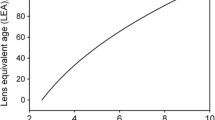Abstract
The attenuation of the perimetric response arising from cataract was investigated and related to the degree of cataract quantified by glare sensitivity. Visual fields were measured with the Octopus and Dicon automated perimeters out to an eccentricity of 30°. Nuclear and non-nuclear cataracts differed in their effect on the perimetric profile. Non-nuclear cataracts exhibited the same qualitative characteristics as a model developed in previous studies, whereby the overall pattern of perimetric attenuation was dependent upon target configuration. For these subjects, perimetric sensitivity was depressed to a greater extent at an eccentricity of 30° compared with fixation when measured with the large projected stimuli, whereas the reverse was true when sensitivity was measured with the small LED stimuli. Conversely, nuclear cataracts depressed perimetric sensitivity to a greater extent at the fovea compared with more peripheral regions for both the large projected and small LED stimuli.
Similar content being viewed by others
References
Abrahamsson M, Sjostrand J (1986) Impairment of contrast sensitivity function (CSF) as a measure of disability glare. Invest Ophthalmol Vis Sci 27:1131–1136
Baraldi P, Enoch JM, Raphael S (1987) A comparison of visual impairment caused by nuclear (NC) and posterior subcapsular (PSC) cataracts. Doc Ophthalmol Proc Ser 14:363–366
Campbell FW, Green DG (1965) Optical and retinal factors affecting visual resolution. J Physiol 181:576–593
Drance SM (1975) Visual field defects in glaucoma. In: Symposium on glaucoma: Transactions of the New Orleans Academy of Ophthalmology. Mosby, St Louis, pp 190–209
Faschinger Chr (1987) Computer perimetry in patients with corneal dystrophies. Doc Ophthalmol Proc Ser 49:61–64
Greve EL (1973) Single and multiple stimulus static perimetry in glaucoma; the two phases of visual field examination. Doc Ophthalmol 36:1–355
Greve EL (1979) Visual fields, glaucoma and cataract. Doc Ophthalmol Proc Ser 19:79–88
Griffiths SN, Barnes DA, Drasdo N (1984) Psychophysical aspects of contrast sensitivity attenuation (abstr). Ophthalmol Physiol Opt 4:189
Griffiths SN, Drasdo N, Barnes DA, Sabell AG (1986) Effect of epithelial and stromal edema on the light scattering properties of the cornea. Am J Optom Physiol Opt 63: 888–894
Guthauser U, Flammer J, Niesel P (1987) Influence of cataracts on visual fields. Doc Ophthalmol Proc Ser 49:39–41
Harrington DO (1981) The visual fields; a textbook and atlas of clinical perimetry, 5th edn. Mosby, St Louis
Hendrickson Ph, Eichenberger D, Gloor B, Robert Y (1987) Influence of ocular media: effect of IOL implantation. Doc Ophthalmol Proc Ser 49:3–8
Hess R, Woo G (1978) Vision through cataracts. Invest Ophthalmol Vis Sci 17: 428–435
Jaffe GJ, Alvarado JA, Juster RP (1986) Age-related changes in the normal visual field. Arch Ophthalmol 104:1021–1025
Kolker AE, Hetherington J (1976) Becker and Shaffer's diagnosis and therapy of the glaucomas. Mosby, St Louis, p 163
Mikelberg FS, Drance SM, Schulzer M, Wijsman K (1987) The effect of miosis on visual field indices. Doc Ophthalmol Proc Ser 49:645–649
Miller D, Jernigan MS, Molnar S, Wolf E, Newman J (1972) Laboratory evaluation of a clinical glare tester. Arch Ophthalmol 87:324–332
Niesel P, Ramel C, Weidmann BOS (1978) Das Verhalten von perimetrischen Untersuchungsbefunden bei Entwicklung einer Katarakt. Klin Monatsbl Augenheilkd 172:477–480
Paulsson LE, Sjostrand J (1980) Contrast sensitivity in the presence of glare light. Invest Ophthalmol Vis Sci 19:401–406
Radius RL (1978) Perimetry in cataract patients. Arch Ophthalmol 96:1574–1579
Van den Berg TJTP (1987) Relation between media disturbances and the visual field. Doc Ophthalmol Proc Ser 49:33–38
Vos JJ (1983) Describing glare at tunnel entrances. 1. The influence of stray light in the eye. Institute for Perception RVOTNO, Report IZF 1983 C-8 Soesterberg, The Netherlands
Wild JM, Wood JM, Flanagan JG (1987) Spatial summation and the cortical magnification of perimetric profiles. Ophthalmologica 195:88–96
Wood JM, Wild JM, Drasdo N, Crews SJ (1986) Perimetric profiles and cortical representation. Ophthalmic Res 18:301–308
Wood JM, Wild JM, Crews SJ (1987) Induced intraocular light scatter and the sensitivity gradient of the normal visual field. Graefe's Arch Clin Exp Ophthalmol 225:369–373
Wood JM, Wild JM, Smerdon DL, Crews SJ (1987) The role of intraocular light scatter in the attenuation of the perimetric response. Doc Ophthalmol Proc Ser 49:51–59
Author information
Authors and Affiliations
Rights and permissions
About this article
Cite this article
Wood, J.M., Wild, J.M., Smerdon, D.L. et al. Alterations in the shape of the automated perimetric profile arising from cataract. Graefe's Arch Clin Exp Ophthalmol 227, 157–161 (1989). https://doi.org/10.1007/BF02169790
Received:
Accepted:
Issue Date:
DOI: https://doi.org/10.1007/BF02169790




